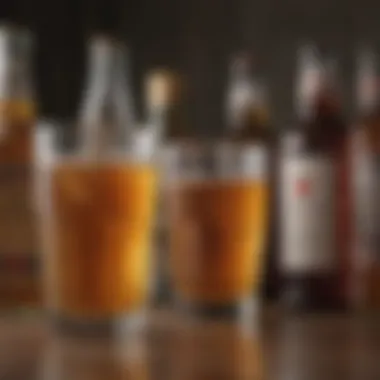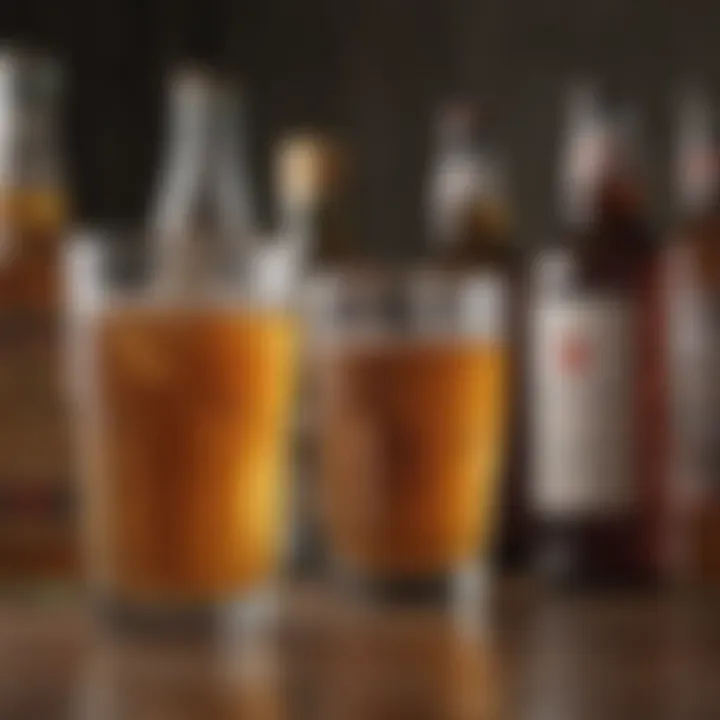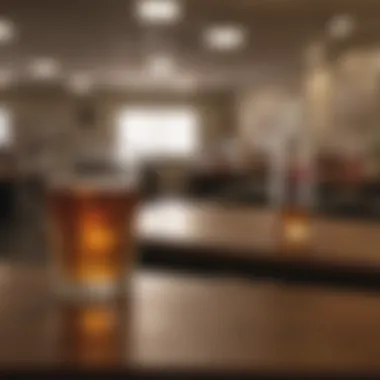Understanding Alcohol Use in Adolescence


Intro
Alcohol consumption in adolescence is a multifaceted issue that intertwines psychological, social, and biological dimensions. Various research studies have recently brought to light not just how prevalent underage drinking is, but also its profound implications for mental health, cognitive development, and social interactions. Understanding the nuances of alcohol use among young people is crucial—not just for the individuals involved but also for parents, educators, and policymakers shaping youth programs and education.
Demographics play a significant role in this discussion. Studies indicates that various factors can propel adolescents toward alcohol consumption, including peer pressure, social norms, and familial influences. This exploration seeks to answer why alcohol appears appealing during this pivotal development phase and what consequences may ensue from such behavior. As young brains are still under construction, the effects of alcohol can be particularly detrimental, leading to both immediate and long-term repercussions.
Moreover, there are substantial societal influences at play—such as marketing strategies and media portrayals—that could normalize alcohol use among youth. With a clear grasp on the broader context, this article will also present potential strategies for prevention and intervention, all aimed at mitigating the risks and consequences of adolescent drinking.
Research Overview
Summary of Key Findings
Research demonstrates a concerning trend: alcohol use in adolescents contributes significantly to various negative outcomes, from impulsive behaviors to long-term substance abuse issues. Some key findings include:
- Increased Risk-Taking: Adolescents engaging in alcohol use often experience heightened risk behaviors, such as dangerous driving or unprotected sex.
- Mental Health Correlations: Higher incidences of anxiety, depression, and other mental health disorders are seen in individuals who consume alcohol at an early age.
- Cognitive Impairment: Early exposure to alcohol can impair memory, attention, and other cognitive functions, potentially resulting in academic challenges.
The data highlights an undeniable correlation between alcohol use and adverse life consequences. This underscores the urgency of addressing this issue comprehensively and proactively.
Importance of the Research in Its Respective Field
Understanding alcohol use in adolescents is critical from both health and educational perspectives. As these individuals navigate a complex social landscape, the insights gleaned from current research can guide effective interventions. With increasing rates of alcohol consumption among teens, the findings can inform public health policies, community programs, and family discussions.
"The trends in adolescent alcohol use reflect larger societal patterns; hence, they require combined efforts from families, schools, and communities to foster healthier choices."
Methodology
Description of the Experimental or Analytical Methods Used
This research employs quantitative and qualitative analyses to provide a comprehensive overview of adolescent alcohol consumption. Surveys and questionnaires are typically distributed among high school students to gather self-reported data regarding their drinking habits, perceived social pressures, and personal experiences with alcohol. Additionally, focus groups may be conducted to dive deeper into individual sentiments and motivations behind alcohol use.
Sampling Criteria and Data Collection Techniques
Sampling generally targets adolescents aged 14-18 attending various educational institutions. By ensuring a diverse range of participants, including differences in socioeconomic status, ethnicity, and geographical locations, researchers can draw more generalized conclusions. Data collection often includes both anonymous surveys and in-depth interviews, ensuring a mix of quantitative data and qualitative insights.
In summary, keeping a close eye on alcohol use during adolescence is essential. The insights not only deepen our understanding of the implications but also pave the way for effective prevention and intervention strategies tailored to this vulnerable age group.
Prelude: Context and Significance
Understanding alcohol use among adolescents is not just an academic exercise—it holds profound implications for public health, education, and societal norms. As adolescents navigate the turbulent waters of teenage years, characterized by peer influence, identity formation, and significant changes in both body and mind, the role that alcohol plays in this exploration is significant and multifaceted. This article delves into the dynamics of alcohol consumption during adolescence, shedding light on trends, motivations, and consequences.
The significance of addressing alcohol use during adolescence lies primarily in its potential long-term effects. Research has indicated that the earlier individuals begin consuming alcohol, the more likely they are to experience various issues later in life—these range from mental health disorders to problems with substance abuse. Recognizing this correlation is critical for educators, policymakers, and healthcare professionals, as early intervention can mitigate negative outcomes.
Moreover, social influences are a powerful driver in adolescent behavior. Teens often find themselves in environments where alcohol consumption is normalized, whether through social gatherings, media representation, or peer pressure. Understanding these social contexts provides insights into why certain adolescents may engage in drinking despite the known risks.
As we explore the topic further, it's crucial to highlight some key elements:
- Emphasizing Awareness: Many adolescents may not fully grasp the implications of alcohol use on their developing brains. There’s need for stronger education initiatives that articulate the risks clearly.
- Legal and Regulatory Factors: Examining the effectiveness of minimum drinking age laws and other regulations will inform future strategies aimed at protecting youth.
- Coping Mechanisms and Emotional Impact: Some teenagers resort to alcohol as a way to cope with stress or emotional turmoil. By understanding these underlying factors, interventions can be tailored more effectively.
"It's not just about abstaining from alcohol; it's about understanding its role in adolescent development and fostering environments that support healthier choices."
As we tread through this complex domain, the focus will remain on not just illuminating statistics or trends, but also providing the insights necessary for motivating change. Engaging with the nuances of adolescent development provides a lens through which we can better comprehend both the present challenges and future solutions regarding alcohol use.
Understanding Adolescent Development
Understanding adolescent development is crucial when discussing alcohol use among youths. Adolescence is not just a transitional stage; it represents a pivotal period where individuals undergo significant transformations across physical, cognitive, and social dimensions. These changes can lead youngsters to either seek out alcohol for various reasons or steer away from it altogether.
Several particular aspects stand out about adolescent development in the context of alcohol consumption:
- Risk and Reward Sensitivity: Adolescents tend to have heightened emotional responses and are more susceptible to peer influence, which can push them towards alcohol use.
- Developing Identity: This period is when young people are figuring out who they are, often experimenting with behaviors that are viewed as cool or rebellious, including drinking alcohol.
- Brain Development: With their brains still in development, especially the prefrontal cortex, which governs rational thinking and impulse control, adolescents can be less equipped to make safer choices regarding alcohol consumption.
Physical Changes and Maturation
During adolescence, significant physical changes take place that can influence alcohol use. This stage of development is marked by puberty, leading to hormonal fluctuations and increased body awareness. Young people may feel peer pressure to consume alcohol as a rite of passage or as a way to fit in. In some cultures, drinking may even be viewed as a sign of maturity. This consideration can lead to risky drinking behaviors as adolescents attempt to navigate their newfound physical identities.
- There is a heightened interest in how they are perceived by others, making social acceptance a powerful motivator.
- Some youths may use alcohol as a coping mechanism for the emotional and physical challenges associated with puberty.
Unpacking these physical manifestations helps in developing effective prevention strategies targeting adolescent populations.
Cognitive Development and Decision-Making
Cognitive development during adolescence indicates that brain architecture is still evolving. Critical thinking and decision-making skills, which play a substantial role in assessing risks versus rewards, are not fully matured. This can lead to impulsive choices, including underestimating the effects of alcohol.
- Judgment and Consequences: Young people often struggle with understanding long-term consequences as their cognitive faculties are not fully developed. This lack of foresight can result in a dangerous mix when it comes to alcohol use.
- Peer Influences: The craving for social acceptance can override sound judgment. Adolescents might choose to drink, believing it will elevate their standing within their peer group.
Insight into these cognitive processes can help tailor interventions to make young people more aware of the risks associated with alcohol consumption.
Social Influences and Peer Pressure


Social context plays an undeniably significant role in shaping adolescent behaviors, particularly related to alcohol consumption. During this phase, friendships and peer relations become paramount, and the desire to belong can drive risky behaviors.
- Conformity to Peer Norms: Adolescents may feel pressure to conform to group norms, leading them to participate in drinking even if they would prefer to abstain. They might fear being ostracized or labeled as "uncool".
- Social Media and Alcohol: The role of social media cannot be understated. Many young people are bombarded with images of peers drinking and having fun, creating a perception that these behaviors are the norm and thus desirable.
Recognizing these social dynamics can aid in developing more effective prevention programs that address peer pressure and provide alternative social pathways for youths.
Prevalence of Alcohol Use Among Adolescents
Understanding the prevalence of alcohol use among adolescents is critical for several reasons. Firstly, it offers insights into the behaviors and attitudes toward drinking during these formative years. Adolescence is a time characterized by exploration and identity formation, making it a key period to analyze consumption patterns. Moreover, exploring these behaviors can unveil broader societal and cultural influences that shape young people’s drinking habits.
The statistics surrounding adolescent alcohol use underline the relevance of this issue in contemporary society. By acknowledging the prevalence, researchers, educators, and policymakers can develop robust strategies to address and mitigate potential harms that arise from underage drinking. This topic provides not just a reflection on the current state of adolescent behaviors but also serves as a warning signal for the negative consequences associated with alcohol use at such a young age.
Statistics and Trends Over Time
Statistical data plays a pivotal role in quantifying adolescent alcohol consumption. Recent studies indicate that a significant portion of adolescents engage in drinking, often leading to risky behaviors and negative outcomes. According to the National Institute on Alcohol Abuse and Alcoholism, around 29% of high school students reported consuming alcohol in the past month. More alarmingly, about 14% engaged in binge drinking during this timeframe. These numbers illustrate that alcohol use remains a substantial issue among youth, with implications that extend well beyond the individual.
The trends over time also reveal shifts in alcohol consumption among adolescents. Compared to the early 2000s, there has been a gradual decline in youth drinking rates. However, this decline doesn’t tell the whole story. While overall consumption may be dropping, certain groups within this demographic still experience high rates of binge drinking and alcohol-related disorders. These changes suggest that while some progress has been made, targeted interventions are still greatly needed to address ongoing challenges.
Demographic Variations and Patterns
Adolescent alcohol use is not uniform; it varies widely across different demographics. Factors such as gender, socio-economic status, geographic location, and ethnicity all contribute to the patterns of alcohol consumption. For example, male adolescents tend to report higher levels of drinking compared to their female counterparts. This disparity may also extend to the contexts in which alcohol is consumed, with boys often participating in riskier drinking environments.
Socio-economic status plays an undeniable role as well. Adolescents from lower socio-economic backgrounds might have limited access to extracurricular activities or constructive engagement opportunities that can deter alcohol use. Conversely, those from affluent neighborhoods might face peer pressures to conform and consume alcohol as a norm within social interactions.
Additionally, geographic location influences drinking behaviors. Adolescents in rural areas may have different access to social events featuring alcohol and may experience unique cultural attitudes toward drinking. In contrast, urban adolescents might encounter a more diverse array of influences regarding alcohol use, leading to varied consumption patterns. Understanding these demographic nuances is essential for crafting effective prevention and education initiatives tailored to local contexts.
"Understanding the prevalence and demographic variations of alcohol use among adolescents allows for targeted interventions that can save lives and reduce harm in our communities."
In summary, the prevalence of alcohol use among adolescents is an intricate dance of statistics and trends framed by social dynamics. By grasping these patterns, stakeholders can better address the multifaceted factors that contribute to underage drinking, leading to more informed policies and initiatives aimed at fostering healthier futures for young people.
Motivations Behind Adolescent Alcohol Use
Understanding the motivations behind adolescent alcohol use is vital. These motivations not only influence the choices made by young people but also affect their social dynamics, mental health, and future behavior. In this section, we will explore why adolescents might turn to alcohol, grappling with curiosity, social pressures, and emotional factors. Through a nuanced lens, we will dissect each of these motivations, providing insight into their intricate roles.
Curiosity and Experimentation
Adolescence is a period marked by exploration and discovery. Young people often have an inherent desire to test boundaries, and alcohol becomes a target for experimentation. The idea of trying something new can be immensely appealing, as teenagers often see drinking as a symbol of maturity or freedom.
The sheer act of breakin' the rules can be exciting. For many, the first sip of alcohol holds a sense of thrill, accompanied by the hope of fun or an escape from their everyday life. Factors like parental restrictions may further fuel this drive—if something's prohibited, it naturally becomes more enticing. Studies show that curiosity is one of the primary gateways leading adolescents to experiment with drinking.
- Young people may engage in drinking due to:
- Boredom and desire for adventure
- Influence from media portrayals
- Stories from older peers about drinking experiences
Social Acceptance and Image
The social landscape of adolescence is particularly dense with peer influences. Alcohol often symbolizes a rite of passage within many social circles. The pressure to conform to what others are doing can be overwhelming. Fitting in is crucial at this age, and for some, drinking serves as the ticket to acceptance or status within a group.
Social media amplifies these dynamics. Platforms like Facebook and Instagram make it all too easy to showcase partying as an alluring lifestyle. When teens see their peers living it up in photos with drinks in hand, they may feel compelled to join in, even if it goes against their initial instincts. The need to maintain a certain image can propel them towards drinking, sometimes leading to risky choices.
Coping Mechanisms and Emotional Factors
For some adolescents, alcohol becomes a coping strategy for navigating the pressures of daily life, such as academic stress, family troubles, or feelings of inadequacy. Instead of seeking help through dialogue or counseling, they might turn to drinking as a release valve for their pent-up emotions. This can lead to significant issues down the line, as these coping mechanisms encourage dependency rather than healthy resolution of feelings.
- Common emotional factors that lead to alcohol use include:
- Feelings of loneliness or isolation
- Anxiety about school performance
- Challenges in personal relationships
"Understanding the motivations behind adolescent alcohol use is not just about identifying negative behavior; it's about comprehending the complex landscape in which these decisions are made."
Ultimately, the motivations for drinking during adolescence go beyond mere fun or rebellion. They stem from a combination of curiosity, the search for social acceptance, and emotional coping mechanisms. Recognizing these factors is a crucial step in addressing the challenges of alcohol use among young people and helps to form effective prevention strategies.
Consequences of Alcohol Use During Adolescence
Understanding the consequences of alcohol use during adolescence is vital to addressing the complexities of adolescent behavior and health. The teenage years are a critical period marked by various physical, emotional, and social developments. When alcohol enters the picture, it can skew these trajectories significantly, often leading to lasting implications. Not only does it affect individuals, but its repercussions ripple through families and communities. By examining these consequences, we not only raise awareness but also pave the way for effective preventative measures and interventions.
Impact on Mental Health
Anxiety and Depression
The relationship between alcohol use and mental health issues like anxiety and depression is well documented. Adolescents often find themselves trying a drink or two as a solution to their worries or low moods. The irony is, while they might momentarily feel a sense of relief, ultimately, alcohol can aggravate anxiety disorders and deepen depressive episodes. One of the key characteristics of anxiety and depression in this context is the cycle they create with alcohol consumption. Drinking may feel like a remedy for emotional pain, but it usually backfires, making things worse.
Adolescents turn to alcohol not just for its euphoric effects but also as a coping mechanism. What’s unique about this feature is how it complicates their emotional landscape. Instead of developing healthy coping strategies, they lean on alcohol, creating dependence that can hinder their emotional growth. As we discuss this, it's important to recognize the disadvantages of overlooking these symptoms. Many adults may dismiss youthful drinking as a rite of passage, ignoring the red flags linked to anxiety and depression.
Mood Disorders
Moving on to mood disorders, the discussion takes on an equally critical tone. Mood disorders can spiral out of control with alcohol consumption, leading to unpredictable behavior and impaired judgment. A teenager struggling with bipolar disorder, for example, may misuse alcohol to self-medicate, only to find their mood swings exacerbated. This dance between mood disorders and alcohol use sheds light on the cyclical nature of the problem, where alcohol can worsen existing conditions.


The fascinating aspect of mood disorders in this scenario is their unpredictable nature, which poses a challenge in treatment. Adolescents can find themselves in a tug-of-war between wanting to feel 'normal' and risking further problems with drinking. Understanding this feature underlines the importance of addressing mood disorders as part of a broader approach to tackling alcohol use.
Cognitive Impairments
Memory Issues
Alcohol's impact on memory during these formative years can be profound and troubling. When adolescents consume alcohol, they often experience short-term memory lapses, affecting their learning and retention. This not only hampers their education but can also contribute to a sense of frustration and disengagement. One key characteristic of memory issues in this context is the interference with neural pathways responsible for memory formation. Adolescents are still in the process of developing cognitive abilities, and introducing alcohol can seriously derail progress.
In discussing memory issues, it's crucial to highlight the long-term disadvantages they can bring. If a young person misses out on retaining information crucial for exams or social interactions, it could the process of achieving personal and academic success significantly. In this way, understanding how alcohol affects memory serves as a warning sign for parents, educators, and teens alike.
Attention Deficits
Attention deficits can be another harsh consequence of alcohol use in adolescents. Alcohol can severely impair concentration and focus. Students might get distracted more easily, leading to poor academic performance or trouble in social settings. The distinctive part of attention deficits caused by alcohol compared to other conditions is how quickly they can manifest after drinking. It’s not uncommon for teens to struggle with tasks they previously handled well, which can lead to frustration and a negative self-image.
Being aware of attention deficits is crucial because it adds another layer to the conversation about adolescent health. These deficits not only impact educational outcomes but can also lead to behavioral issues. Adolescents may spiral into a pattern of avoidance and disengagement, preferring to retreat into the comfort of alcohol rather than face their academic or social challenges.
Social and Behavioral Outcomes
Risky Behavior
Alcohol use among adolescents is often linked with an uptick in risky behaviors. Teens under the influence are far more likely to engage in unsafe activities, from unprotected sex to reckless driving. The troubling bit here is that risky behavior can become a norm in social circles, desensitizing them to potential dangers. One of the core aspects of this is the push-and-pull dynamic often present: adolescents might be drawn to drinking to fit in, then find themselves participating in increasingly dangerous activities once they’ve started.
Understanding this risky behavior is crucial, as it highlights the real consequences that extend beyond health. Many experience regrettable situations or trauma resulting from poor decision-making while drinking. The social pressure that drives teens to drink is not just a phase; it can have lasting repercussions on their life paths.
Academic Challenges
Finally, the academic challenges stemming from alcohol use cannot be ignored. Poor performance, dropouts, and disengaged students paint a concerning picture of how alcohol can derail educational aspirations. Alcohol impairs cognitive functions and leads to absenteeism, creating barriers to learning. A unique feature of this challenge is its self-perpetuating nature: failing grades can lead to increased drinking as a form of escapism, creating a vicious cycle.
Recognizing these academic challenges helps parents, educators, and the community at large to understand the far-reaching consequences of adolescent drinking. While some may see it simply as youthful exuberance, it often translates into lost opportunities and futures.
Understanding the consequences of alcohol use during adolescence is not just about figures and statistics; it is about the personal narratives behind those numbers. By emphasizing these challenges, we can foster a deeper awareness and initiate more meaningful dialogues about prevention and education.
Legal and Regulatory Context
Understanding the legal and regulatory context surrounding alcohol use among adolescents is pivotal for a broad perspective on this issue. The laws and regulations not only serve as a framework for controlling access to alcohol but also reflect cultural attitudes towards youthful drinking behavior. This section sheds light on how these legal parameters influence adolescent behavior, the social implications they carry, and potential areas for policy enhancement.
Minimum Drinking Age Laws
Minimum drinking age laws are designed to restrict the purchase and consumption of alcohol among those under a certain age—typically 21 in many states across the U.S. These laws often spark vigorous debates about their effectiveness and necessity.
One major point here is the argument that these laws can be a double-edged sword. On one hand, they aim to protect young people from the harmful effects of alcohol, which can have lasting impacts on their physical and mental health. On the other hand, strict enforcement may push underage drinking underground, leading to riskier consumption patterns, such as binge drinking in unsafe environments.
- Research indicates that where the minimum drinking age laws are strictly enforced, there tends to be a lower rate of alcohol consumption among teens.
- However, this same research shows that adherence can vary significantly from region to region, often dictated by cultural attitudes towards alcohol.
The challenge lies in balancing these laws with educational programs that address responsible consumption. An important aspect of these laws is their capacity to limit access to alcohol during a formative stage of life.
"Laws are meant to serve the society, but too strict, they might backfire, causing the opposite of the intended outcome."
Advertising and Marketing Regulations
Advertising and marketing regulations surrounding alcohol significantly influence adolescent perceptions and behaviors. The way alcohol is marketed��—especially through social media and other digital platforms—plays an important role in shaping attitudes. Advertising strategies often target young audiences through trendy promotions and aspirational messaging, presenting alcohol consumption as a rite of passage or a social norm.
- Regulatory frameworks aim to limit the exposure of adolescents to such messages. Various countries have set guidelines on how alcohol can be advertised, especially during times when young audiences are heavily engaged with media.
- For instance, restrictions may include prohibiting ads during children's programming or placing limits on the platforms available for alcohol advertising altogether.
However, these regulations often lack enforcement mechanisms. Studies have shown that despite existing laws, alcohol brands frequently find creative ways to circumvent marketing restrictions, directly appealing to younger demographics. As technology evolves, regulators face added complexity in navigating online platforms where traditional rules may not apply seamlessly.
Prevention and Education Strategies
Addressing alcohol use among adolescents requires a multi-faceted approach, emphasizing the need for effective prevention and education strategies. It’s vital to tackle this issue comprehensively, as understanding the context is key to developing programs that genuinely resonate with young people. Engaging strategies can prevent early initiation of alcohol use, mitigate its negative effects, and foster healthier choices among youth.
Why Prevention Matters
The significance of prevention in the context of adolescent alcohol use cannot be overstated. Early exposure to alcohol can lead to a plethora of issues, including mental health disorders, cognitive impairments, and disrupted social development. Implementing prevention strategies can not only debunk myths surrounding alcohol consumption but also equip young people with the critical thinking skills necessary to resist peer pressure.
- Educating on Risks:
- Encouraging Healthy Coping Mechanisms: Strategies that focus on developing emotional resilience can help young people turn to healthier alternatives when faced with stress or peer pressure.
- By informing adolescents about the risks associated with alcohol use, including brain development hazards and long-term addiction potential, we set a foundation for safer choices.
School-Based Programs
School environments are pivotal in shaping adolescent behavior, and thus it is crucial to leverage them as platforms for effective alcohol education. Implementing comprehensive school-based programs helps bridge the gap between theory and practice, offering students hands-on learning experiences and ongoing support.
Key Features of Effective Programs
- Curriculum Integration
Integrating alcohol education into subjects like health, social studies, or physical education ensures that students receive consistent messages. - Interactive Workshops
Engaging students through role-playing or scenario-based learning can encourage them to think critically about their choices. - Peer Leadership Opportunities
Training older students to lead discussions around alcohol use can create a supportive environment where younger peers feel empowered to discuss their concerns openly.
“Education is the most powerful weapon which you can use to change the world.”
Nelson Mandela
Focusing on creating a culture that prioritizes healthy living can significantly reduce the likelihood of alcohol misuse among adolescents.


Community Engagement Initiatives
When communities come together to address alcohol use, their collective voice can wield considerable power. Effective community engagement initiatives not only raise awareness but also foster a supportive network that can help deter alcohol use among adolescents.
Community Efforts
- Local Workshops and Seminars
Hosting events that bring together experts, families, and youth allows for a rich exchange of ideas and strategies. These events can focus on communication and how to develop positive relationships with adolescents regarding alcohol use. - Collaboration with Local Businesses
Partnerships with local businesses to promote alcohol-free events can create safe spaces where youth can socialize without the pressure to drink. - Social Media Campaigns
Leveraging platforms like Facebook and Instagram to share positive messages about sobriety and healthy choices can reach adolescents where they are most engaged.
Family Involvement and Support
The role of family in preventing alcohol use cannot be overlooked. Families are often the first line of defense when it comes to guiding adolescents through the challenges they face.
Strategies for Family Involvement
- Open Communication
Encouraging open dialogue about alcohol can demystify the subject and reduce the allure of drinking. Parents engaging in discussions about their own experiences can foster a sense of understanding and trust. - Setting Clear Expectations
Having established family rules about substance use creates a framework for adolescents, making it clear what is acceptable behavior. - Participation in Community Events
Involving the entire family in community initiatives can strengthen bonds and ensure that the message of alcohol resistance is consistent, whether at home or in the community.
Creating a network of support through family, schools, and community organizations is essential to combat alcohol use among adolescents and to foster an environment where safer choices are not just advocated, but practiced.
The Role of Technology in Alcohol Use Among Adolescents
The digital age has brought about significant changes in social dynamics, and this is no different in the context of adolescent alcohol use. With smartphones and the internet basically being a ubiquitous presence in young people's lives, the way they interact with their peers, access information, and even consume media has altered. This section explores both the impact of social media and online resources on adolescent drinking behaviors while considering the benefits and potential pitfalls associated with them.
Social Media Influence
Social media platforms have evolved into a powerful force that shapes adolescent behavior. These platforms can act as a double-edged sword. On one hand, they create a space where youths can share their experiences; on the other hand, they also promote certain drinking norms and lifestyles.
Adolescents often see alcohol consumption glamorized in posts, stories, and TikTok videos, which can unintentionally normalize excessive drinking. Research indicates that peer-supported behaviors exhibited online often trickle down to real-life decisions. For instance, a study showed that users exposed to pro-drinking content were more likely to engage in heavy drinking themselves. Furthermore, social norms established in digital circles can magnify peer pressure, making young individuals feel the need to conform to group expectations when it comes to alcohol use.
"The influence of social media on teenage lifestyles is undeniable, factoring heavily into their risk-taking behaviors, including alcohol use."
In an age where likes and follows can sway perceptions, it’s essential for parents, educators, and policymakers to understand the messages young people are consuming online. Strategies could include educating adolescents about discerning content, as well as fostering critical thinking skills when it comes to online impressions.
Online Resources for Education
While the internet hosts a myriad of potentially harmful influences, it also provides essential educational resources regarding alcohol use and its implications. Websites, webinars, and even specialized online support groups can deliver valuable information about the effects of alcohol on health, legal ramifications, and coping strategies.
For example, active platforms like Reddit create forums where young people can ask questions anonymously, thus enabling a candid discussion about their concerns regarding alcohol use. Communities formed around such topics can foster healthy dialogue, help adolescents feel less isolated, and give them access to factual content from credible sources.
Moreover, initiatives by educational institutions and non-profits are increasingly utilizing digital platforms to spread awareness. Campaigns are targeted specifically at teens, encouraging them to reflect on their choices and understand the long-term impact of their actions. When combined with real-life community engagement, these online resources can deliver a more rounded approach to prevention and education.
Future Directions in Research and Policy
Exploring the dynamics of adolescent alcohol use requires a lens that acknowledges not just the present concerns but also the evolving nature of this issue. Research in this area has typically revolved around immediate outcomes, often overlooking how patterns shift over time and adapt to new societal influences. Moving forward, it’s critical to hone in on emerging trends and innovations that can reshape our understanding and approaches.
Emerging Trends and Innovations
One of the key trends in understanding alcohol use among adolescents is the integration of technology into research methodologies. For instance, mobile health applications and wearable devices provide real-time data on consumption patterns and related behaviors. This tech-savvy approach allows researchers to gather nuanced insights into how and why adolescents engage with alcohol, beyond what traditional surveys can capture.
Furthermore, neuroimaging studies unveil the biological underpinnings that explain why some adolescents may be more prone to risky alcohol behaviors. These findings open avenues for targeted interventions, enriching the dialogue around cognitive development in youth.
In addition to these technological advancements, there’s an evolving norm around social attitudes towards alcohol. Studies indicate a cultural swing in perceptions, suggesting younger generations may be less inclined to view drinking as a rite of passage. Capturing these shifting narratives in ongoing research can help tailor programs that resonate with contemporary youth.
As youth culture evolves, so too should the methods we apply to comprehend and address alcohol use in adolescents.
Policy Recommendations for Improvement
When it comes to policy, basing decisions on robust data is paramount. Policymakers should consider implementing evidence-based interventions that reflect findings from the latest research. This approach ensures that strategies deployed in schools and communities are not only scientifically sound but also culturally relevant.
Some recommended policies include:
- Expanding funding for preventive education programs aimed at decreasing alcohol use.
- Enhancing collaboration between schools, families, and community organizations to create a multifaceted support system.
- Evaluating existing drinking age laws and their effectiveness in deterring underage drinking; there is evidence suggesting adjustments may be necessary to align with contemporary societal norms.
Additionally, increased transparency in alcohol advertising and a reconsideration of marketing practices targeting youth can significantly influence perceptions and behaviors around alcohol consumption.
These recommendations, when thoughtfully integrated with ongoing research, can guide communities towards a healthier understanding of the implications surrounding adolescent alcohol use.
Closure: Key Takeaways and Implications
The exploration of alcohol use during adolescence reveals a layered and intricate relationship that carries profound implications for individuals and society. Understanding the nuances of why and how adolescents engage with alcohol allows us to address not only their immediate safety but also their long-term psychological and social development.
Emerging Patterns: Trends indicate that the prevalence of alcohol consumption among adolescents is continually evolving. Recognizing these patterns can help parents, educators, and policymakers stay ahead of the curve. For instance, the rise of social media and digital communication offers a unique conduit for both peer influence and educational outreach, presenting both challenges and opportunities.
Using demographic insights can further tailor prevention strategies more effectively. Variations among different groups show that one-size-fits-all approaches might fall short. Analyzing specific demographics can illuminate unique psychological motivators, revealing that some adolescents may turn to alcohol more for social acceptance while others might be using it as a coping mechanism.
Consequences of adolescent alcohol use effect not just the individuals but ripple through families and communities. The mental health implications, such as anxiety, depression, and riskier behaviors, can set the stage for a rough road ahead. It is crucial to highlight that the stakes include diminished academic performance alongside social and cognitive impairments that can affect future opportunities.
Moreover, the role of education and prevention strategies is paramount. Schools and communities are increasingly recognizing the need for structured programs that not only address alcohol use but also impart essential life skills. Engaging families in the conversation, providing information on recognizing warning signs, and including community-driven initiatives can create a supportive atmosphere for adolescents.
"Investing in adolescent education about alcohol not only protects individual futures but reinforces societal well-being as a whole."
Finally, effective policy recommendations are vital for curbing the risks associated with alcohol use. Adjustments in legal frameworks, advertising limitations, and enhancing age verification processes can serve to protect vulnerable populations. Moreover, fostering public discourse about alcohol as a public health issue can standardize the conversation across various societal platforms.
In summary, grasping the intricacies of alcohol use among adolescents requires a multi-faceted approach. Attention to individual motivations, demographic factors, consequence mitigation, and educational outreach are paramount. Each element ties back to the broader picture, reinforcing the importance of vigilance, empathy, and proactive measures within our societies to safeguard our youth. Understanding and acting upon these takeaways can empower us to foster healthier environments for adolescents navigating the tumultuous waters of this critical developmental stage.







